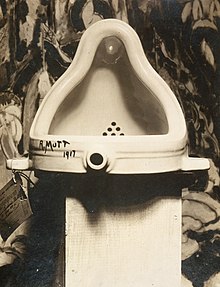現成物

現成物(英語:found object,源自法語objet trouvé的仿譯)又稱為現成藝術(found art)[1][2][3],是由日常物品創造的藝術品,有時會加以改裝,所用的這些物品通常不被認為是藝術創作的材料,並且一般具有非藝術功能。[4]巴勃羅·畢加索最早公開使用了這一概念,當時他將打印出的藤椅圖像粘到他的畫作《有藤椅的靜物》(Still Life with Chair Caning,1912年)上。幾年後馬塞爾·杜尚製作的一系列現成品(ready-made)被認為達到了這一概念的極致,他挑選了一些日常物品並且在完全不經修飾的情況下指定這些物品為藝術品。[5]最著名的例子是他1917年的作品《噴泉》。這是他從商店購買的一個標準小便斗,他直接將其放在一個基座上展示。從嚴格意義上說,「ready-made」一詞僅適用於杜尚的作品[6]。他在紐約期間從服裝行業借用了這個詞(法語:prêt-à-porter ,意為「成衣」) ,「ready-made」尤指其1913年至1921年間的作品。
現成物從藝術家賦予它們的地位以及物品本身附帶的社會歷史中獲得它們作為藝術品的身份。後者可以通過物品的磨損來展現(如柯特·希維特斯的拼貼畫),也可以通過其能夠被識別為消費品標誌的特性來展現(如海姆·施泰恩巴赫的雕塑)。現成物所處的環境也是需要考量的關鍵因素。以這種方式抬高普通物品地位的想法起初是對當時公認的藝術與非藝術之間區別的一個大膽挑戰。雖然這一行為現在可以被藝術界所接受,但它仍舊繼續引起質疑。比如泰特美術館在特納獎展覽中展出的特蕾西·艾敏作品《我的床》(My Bed)就極具爭議。這一作品就是她自己睡過的一張凌亂的床以及周圍散落的衣服和雜物,直接從她的臥室搬到泰特美術館展覽。從這個意義上說,藝術家給了觀眾時間和舞台來思考這個物體。因此,現成物可以促使觀察者進行哲學反思,包括厭惡、冷漠、懷舊到同理心等。
作為一種藝術形式,現成物往往包含了藝術家的想法,至少包括了藝術家將物品指定為藝術這一行為本身,而且藝術家總會通過一個作品標題來進一步表達其想法。現成物通常會經過一定程度的修改,儘管有時無法被識別,就像杜尚的現成品一樣。最近的批判理論則認為,指定任何物品為藝術以及將其移動到他處展示的行為(包括杜尚的現成品)都構成了對物品的修改,因為它改變了人類對它用法、壽命或狀態的看法。
參見
[編輯]參考文獻
[編輯]- ^ Stribling, Mary Lou. Art from Found Materials, Discarded and Natural. Crown Publishing Group. 1970: 2 [2021-06-25]. ISBN 0-517-54307-9. (原始內容存檔於2022-06-16).
Found Art is a term coined to describe works which are composed in part or entirety of natural or salvaged objects.
- ^ Dayton, Eric. Art and Interpretation: An Anthology of Readings in Aesthetics and the Philosophy of Art. Broadview Press. 2 February 1999: 259 [2021-06-25]. ISBN 1-551-11190-X. (原始內容存檔於2022-06-16).
On the surface, anyway, there is no mystery about the making of the great bulk of works of artifactual art; they are crafted in various traditional ways—painted, sculpted, and the like. (Later, I will attempt to go below the surface a bit.) There is, however, a puzzle about the artifactuality of some relatively recent works of art: Duchamp's readymades, found art, and the like. Some deny that such things are art because, they claim, they are not artifacts made by artists. It can, I think, be shown that they are the artifacts of artists. (In Art and the Aesthetic I claimed, I now think mistakenly, that artifactuality is conferred on things such as Duchamp's Fountain and found art, but I will not discuss this here.)
- ^ Tankersley, Leeana. Found Art: Discovering Beauty in Foreign Places. Zondervan. 14 June 2009: 2 [2021-06-25]. ISBN 978-0-310-56182-8. (原始內容存檔於2022-06-16).
... That is what we call found art—a genre of art that started umpteen years ago with a guy in New York who took a urinal and cleverly refashioned it into a fountain. Found art is created when odd, disparate, unlikely, even long-abandoned castoffs are put together with other similarly unexpected remnants to create something new and, if all goes as planned, lovely.
- ^ definition of Objet trouvé at the MoMA Art Terms page
- ^ Chilvers, Ian & Glaves-Smith, John eds., Dictionary of Modern and Contemporary Art, Oxford: Oxford University Press, 2009. pp. 587–588
- ^ Marcel Duchamp and the Readymade (頁面存檔備份,存於網際網路檔案館), MoMA Learning
